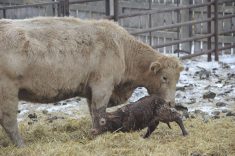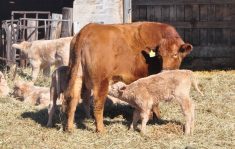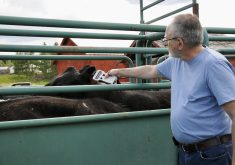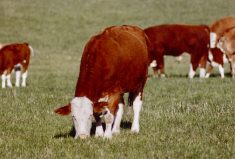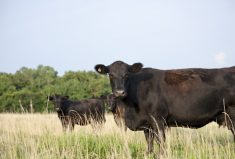Glacier FarmMedia – The calf was breech.
Standing a few feet away, Brandon veterinarian Dr. Grayson Ross coached producer at the rear of the cow through the potential disaster.
“Get it in your mind’s eye,” he said. “You’ve got the rump of a calf right in front of you. The tail’s there. You’ve figured out where the hocks are kind of down below.
Read Also
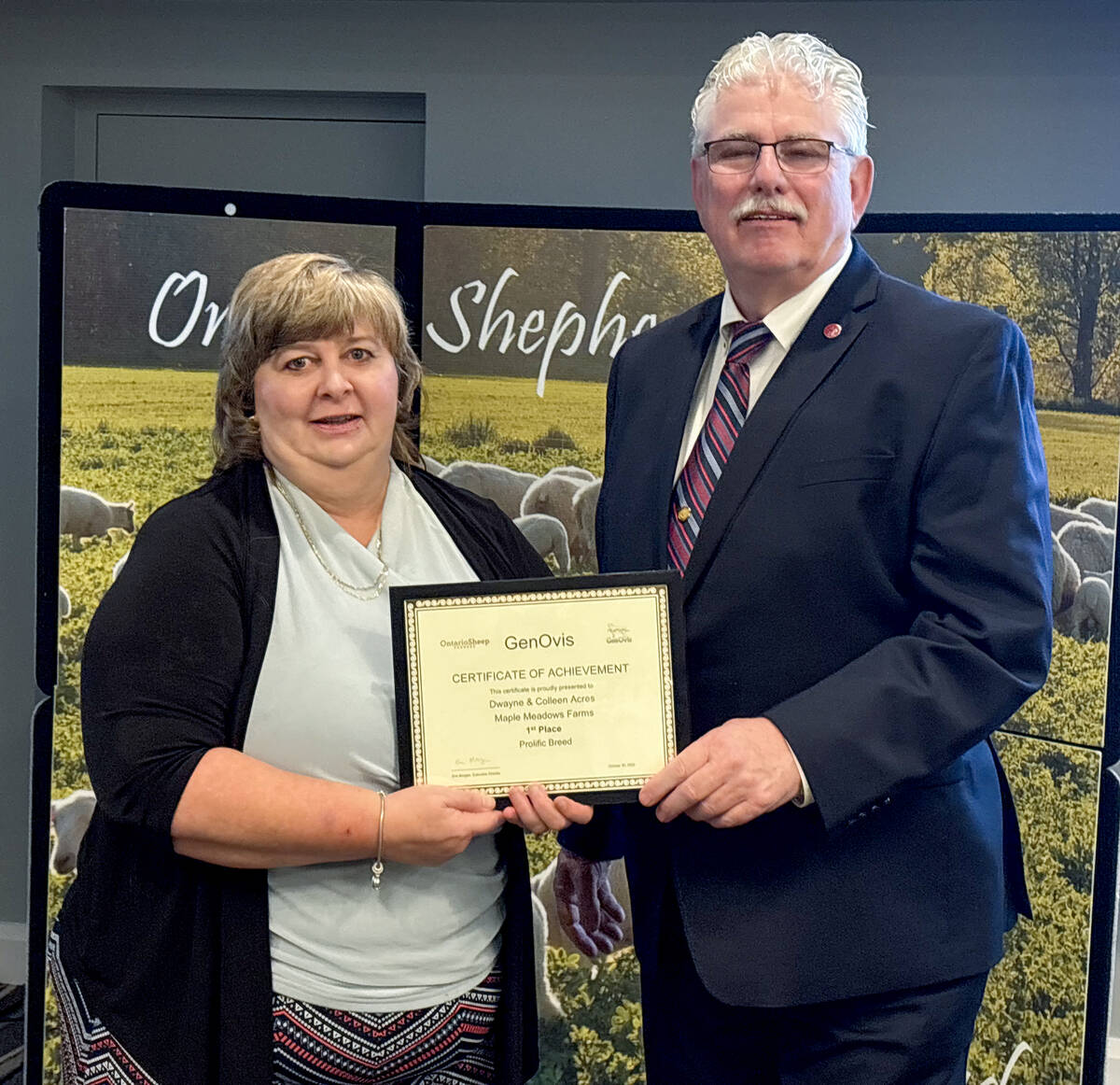
GenOvis awards presented at Ontario Sheep Farmers’ annual meeting
Producers and youth were recognized for their contributions during the Ontario Sheep Farmers’ annual GenOvis and leadership awards.
“If you can manipulate those hocks and push them away from you, the secondary effect from that is that, as you push the hock away, it’s going to cause the fetlock lower down … to come closer towards you. So, then you can cup that lower limb, cup that hoof, pull it up and pop it into the birth canal.”
Why it matters: Dealing with difficult births, or dystocia, is a reality for any cow-calf producer.
The calf was repositioned. The chains went on. A few minutes later, it was out and in the recovery position on the floor.
The entire affair was much calmer, cleaner and handled with much more humour than a typical breech birth.
After all, there were no stakes. The calf was rubber.
Clover, the life-sized calving model, has been making the rounds in the last few months. Most of that string of beef production seminars have had to do with how to diagnose and intervene in a birth, when to intervene and when it’s time to phone the veterinarian.
Ross goes by the 30-minute rule, Manitoba Ag Days attendees heard. If birth has stalled for half an hour, it’s time to glove up. Likewise, if the producer has been trying to assist with no success for 30 minutes, it might be time for a vet visit.
It’s a general rule, Ross acknowledged, and one that must be applied in the context of each circumstance. A cow with her first calf may react differently than an experienced mother, and the threshold for intervention will be different.
“It’s one of those situations where it’s definitely better to be proactive than reactive,” he said.
Dr. Shania Jack, who works out of Morden and Glenboro, suggested producers intervene if the first stages of calving—things like the cow isolating herself when dilation has started—lasts more than six hours or if there’s “continuous cycling going on.”
“So, she’s pushing, lying down, standing up, pushing again and nothing’s happening.”
Heifers should see a calf delivered within 90 minutes after the first sign of feet or water bag, Jack said. For mature cows, that timeline is an hour. “If that’s not happening, we need to check and see what’s going on,” she said.
If there’s a foot out and nothing’s progressing for half an hour to 45 minutes, it’s also time for a check.
General tips
Intervention should come with a few general rules, Ross advised. Firstly, palpitation gloves and clean chains are a must. Not only do gloves keep the producer cleaner, but they help mitigate the risk of damage inside the cow as the producer feels around. Likewise, he said, lubricant will make things easier on the cow.
Chains should be double looped to spread out pressure on a calf’s legs. Those loops should be positioned with one above the fetlock and the second above the hoof.
Producers also might want to keep epinephrin on hand. A dose to the neck muscle of the cow relaxes the uterus within around five minutes, Ross said. Once that happens, the calf falls away further into the uterus.
“It sounds kind of counter intuitive. You would think that you want the calf right there so you don’t have to reach in as far. But actually, the further it falls into the cow, you get a lot more room to work,” he said.

Breech birth
Breech births are among the most common calls Ross gets and are some of the most difficult for the producer to resolve on their own.
It’s not just the matter of the backwards calf, he noted. A breech calf will also have their legs tucked underneath them.
The producer will know they’re dealing with a breech if they feel only the tail and rump, no hoofs. From there, the calf should be pushed back into the uterus, so the legs can be manipulated (cupping the hoof with the palm to avoid damage to the cow). Then, the calf is pulled backwards.
It’s not an easy or quick fix, he said. Producers will need patience.
It’s often helpful to have another set of hands during a breech birth, Jack said. With a chain, the helper can provide some upwards pressure on the flexed leg to keep it from slipping back down while the producer manipulates the limb. She also noted that the producer should be pushing the calf up, not just back, in the uterus to make it easier to grab the hock.
Once a backwards pull starts, Jack said, it’s time for a little urgency.
“They can’t get the oxygen…the umbilicus is pinched off once they’re into that birth canal and they can’t breathe,” she said.
“Our frontwards-facing calves, once we get that chest out, we have a minute to breathe and take a moment with that calf. We don’t have to panic to rush to get them out super quick. We need to take some time. Allow the cow to recover and allow the calf to recover once that chest is out.”
There is also more urgency if the birth has stretched too long, she noted, since both calf and cow will be under stress and losing strength.
After the breech
Ross also urged producers to remember the “Rule of breeches”: Check for pairs and check for tears.
Despite a producer’s best efforts, something may have torn during the intervention. That doesn’t happen often, if producers are being careful and making sure to cup the hoofs, he said, but “once you’ve found out that it’s probably happened, it’s often too late for the animal.”
About half of breech births are twins, he also noted, since the second body in the uterus can make it difficult for the first to be correctly positioned.
Don’t panic
Knowing when to take your time can be critical, Jack said. Once birth is underway and things are going poorly, it’s common for producers to rush, leading to mistakes or injury to either cow or calf.
“I know it’s a stressful time of year and it’s their livelihood and they don’t make money off a dead calf, but taking a moment (is important), making sure that everything’s correct before we pull that calf,” she said.
It is comparatively easy to cause damage while pulling, she cautioned.
In the case of a backwards calf, as long as the hocks aren’t out yet, the producer can take a few minutes and help dilate the canal with their arms to make the pull easier on the cow.
In the case of a hip-locked calf or too-big calf where things have progressed too far for a c-section, a producer can try and rotate the calf.
The gap in a cow’s pelvis is bigger vertically, Jack noted, and crossing the hooves before the pull will rotate the calf 45 to 90 degrees so the hips can slide through. If the calf is stifle-locked, meaning the knees have come up and are caught on the brim of the pelvis, adding a downward direction to the pull can help.
C-section
It’s better, however, to know whether a c-section is needed before things get to that point.
Producers should have room to reach in and feel all around the calf. If not, it’s likely too big to pull.
“If you can easily pull both of the calf’s fetlocks about a hand’s length, or about four inches, outside the vulva and the calf’s head is completely within the birth canal, that calf can typically be delivered just by pulling it,” Jack said.
Hoofs that come out crossed, however, should be a big red flag.
“What’s happening is their big shoulders are entering the birth canal and there’s so much pressure that it’s crossing those front feet,” Jack said.
For backwards calves, the hips are in the pelvic canal if the hocks are out, she noted. Since that’s the widest part of the body, if the producer can feel around the hips at this point, the calf will likely fit.
Pain control
Jack also urged producers to have pain medication for the cow on hand any time they’ve had to pull.
“Back in the day, we didn’t have access to these sort of medications,” she said, but added that, in the modern day, those medications can and should be sourced through a farm’s veterinarian.
Farmer stress
It’s never a good feeling when calving is going wrong, Jack acknowledged. Once farmers make the call and it becomes a waiting game for the veterinarian to arrive, she advises her clients take some time to prepare. Have warm water handy and an area set up for a possible c-section.
“Getting that stuff organized while you’re waiting for the vet helps to keep your mind a little bit preoccupied so that you’re not stressing about the fact that you can’t get this calf out of the cow,” she said.
– Alexis Stockford is associate editor with the Manitoba Co-operator.






